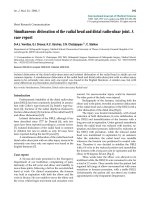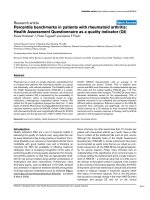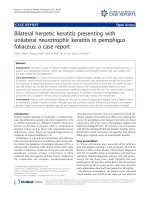Báo cáo y học: " Pneumopericardium should be considered with electrocardiogram changes after blunt chest trauma: a case report" pot
Bạn đang xem bản rút gọn của tài liệu. Xem và tải ngay bản đầy đủ của tài liệu tại đây (984.9 KB, 5 trang )
BioMed Central
Page 1 of 5
(page number not for citation purposes)
Journal of Medical Case Reports
Open Access
Case report
Pneumopericardium should be considered with electrocardiogram
changes after blunt chest trauma: a case report
ArjanJMKonijn*
1
, Peter HM Egbers
1
and Michaël A Kuiper
1,2
Address:
1
Department of Intensive Care, Medical Centre Leeuwarden, 8901 BR, Leeuwarden, The Netherlands and
2
Department of Intensive Care,
Academic Medical Centre, 1100 DD, Amsterdam, The Netherlands
Email: Arjan JM Konijn* - ; Peter HM Egbers - ; Michaël A Kuiper -
* Corresponding author
Abstract
Introduction: Electrocardiogram (ECG) abnormalities in patients with blunt chest trauma are
diverse and non-specific, but may be indicative of potentially life-threatening conditions.
Case presentation: We report a rare case of pneumopericardium with extreme ECG
abnormalities after blunt chest trauma in a 22-year-old male. The diagnosis was confirmed using
computed tomography (CT) scanning. The case is discussed, together with its differential diagnosis
and the aetiology of pneumopericardium and tension pneumopericardium.
Conclusion: Pneumopericardium should be distinguished from other pathologies such as
myocardial contusion and myocardial infarction because of the possible development of tension
pneumopericardium. Early CT scanning is important in the evaluation of blunt chest trauma.
Introduction
When an electrocardiogram (ECG) is obtained during the
diagnostic processing and evaluation of a trauma patient
(as in the present case), it is important to realize that ECG
findings in patients with cardiac trauma are diverse and
non-specific. These findings may be non-specific ST-seg-
ment or T-wave changes, axis deviation and dysrhythmias,
such as premature atrial contractions, bundle branch
blocks and ventricular fibrillation [1]. Diagnostic consid-
erations in a patient with blunt chest trauma and ECG
abnormalities include, amongst others, myocardial con-
tusion and myocardial ischaemia. Other causes involve
the presence of air in thoracic structures that do not nor-
mally contain air, for example pneumothorax, pneumo-
mediastinum and pneumopericardium. These options are
discussed in a stepwise manner and related to the patient
in this case report.
Case presentation
A 22-year-old male, with no previous medical history, was
admitted to the intensive care unit (ICU) at our hospital
with blunt thoracic trauma and near-drowning after a
high-energy trauma. The man had been driving a car
when, for no apparent reason, he lost control and drove
into a ditch filled with water.
The patient consequently aspirated water, but managed to
reach solid ground. He was transported by ambulance to
the hospital emergency unit, where he was found to be in
respiratory failure, probably as a result of severe lung con-
tusion. He was subsequently intubated and mechanically
ventilated. During the first few days of admission, pres-
sure-controlled ventilation was used with relatively high
ventilator settings. During the first hours after admission
these settings were a positive end-expiratory pressure level
of 18 cm H
2
O, inspiratory pressure level of 13 cm H
2
O, a
Published: 4 April 2008
Journal of Medical Case Reports 2008, 2:100 doi:10.1186/1752-1947-2-100
Received: 5 November 2007
Accepted: 4 April 2008
This article is available from: />© 2008 Konijn et al; licensee BioMed Central Ltd.
This is an Open Access article distributed under the terms of the Creative Commons Attribution License ( />),
which permits unrestricted use, distribution, and reproduction in any medium, provided the original work is properly cited.
Journal of Medical Case Reports 2008, 2:100 />Page 2 of 5
(page number not for citation purposes)
fractional inspired oxygen level of 60% and a respiration
frequency of 30 cycles per minute. No recruitment
manoeuvre was performed. A central venous line was
inserted into the right femoral vein. Other than fractures
of the left clavicle and superficial haematomas, there were
no abnormalities on physical examination of the thorax.
In particular, no asymmetrical pulmonary auscultation,
subcutaneous emphysema or abnormal heart sounds
were present. Chest radiography and a 12-lead ECG were
performed on admission (Figure 1). No significant abnor-
malities were observed at the time, but shortly thereafter
the ECG showed ST-depression in leads II, III, aVF and V3
and V4. No major haemodynamic problems occurred,
and the creatine phosphokinase and accessory MB-frac-
tion indicated only a loss of skeletal muscle. However,
extreme ECG abnormalities developed during the follow-
ing hours (Figure 2 and 3). CT scanning of the thorax, per-
formed approximately 12 hours after admission, showed
a pneumopericardium, as well as pneumomediastinum
and bilateral pneumothorax (Figure 4). Severe lung con-
tusion and haematothorax were also apparent on these
images.
Transoesophageal echocardiography (TEE) was per-
formed after transthoracic echocardiography had failed to
deliver the required image quality. TEE did not identify
any wall motion abnormalities, and the accident
appeared to have had no abdominal or cerebral repercus-
sions.
Both the pneumothorax and pneumopericardium
resolved after the insertion of a left-sided chest tube. The
right-sided pneumothorax resolved spontaneously, after
which the patient made a rapid recovery and was dis-
charged from the ICU on day 5. He was discharged from
hospital five days later, having made a complete recovery.
Discussion
In this case, a likely differential diagnosis was myocardial
contusion, which has a broad variety of presenting symp-
toms, the most frequent being precordial pain which is
not relieved by analgesia. In addition to ECG changes,
other findings include dyspnoea, pericardial friction rub,
pulmonary rales and an elevated central venous pressure.
This complex of symptoms may mimic those of acute cor-
onary syndrome, although symptoms may also be com-
pletely absent. Myocardial contusion can be diagnosed
using echocardiography, as this imaging modality visual-
izes the actual contusion as well as changes in cardiac
chamber size, wall motion abnormalities and the pres-
ence of cardiac tamponade [2]. Echocardiography was
performed on this patient after pneumopericardium had
been diagnosed. Although cardiac contusion might easily
have coexisted, none of the aforementioned abnormali-
ties were seen. In such a situation it is important to recog-
nize the inferior diagnostic quality of transthoracic
echocardiography compared with TEE.
ECG performed on admissionFigure 1
ECG performed on admission.
Journal of Medical Case Reports 2008, 2:100 />Page 3 of 5
(page number not for citation purposes)
ECG showing the most striking abnormalitiesFigure 2
ECG showing the most striking abnormalities. Interestingly, there is no change in QRS amplitude, frequently seen in
pericardial tamponade. Owing to technical problems, lead V2 is absent.
ECG performed shortly after drainageFigure 3
ECG performed shortly after drainage. The remaining abnormalities resolved completely in approximately 12 h. Owing
to technical problems, lead V2 is absent.
Journal of Medical Case Reports 2008, 2:100 />Page 4 of 5
(page number not for citation purposes)
Acute coronary syndrome was unlikely to occur in this
patient because he was young and had no predisposing
medical history, such as angina [1]. However, even in
young people traumatic myocardial infarctions have been
reported that can result from acute thrombotic coronary
occlusion, intimal tears and vessel rupture [3]. As men-
tioned above, the cardiac enzyme profile indicated a loss
of skeletal muscle, with serial measurements of CK and
accessory MB-fraction showing peak levels of 2,600 and
29 U/l, respectively. Unfortunately, the level of troponins,
which has been shown to be more useful in detecting
myocardial injury than CK and CKMB over the past dec-
ade, was not measured [4]. Nonetheless, it was concluded
that significant myocardial contusion or infarction was
highly unlikely.
The presence of extraluminal air is a frequent complica-
tion in cases of blunt thoracic trauma, because the differ-
ing electrophysiological behaviour of air can cause the
ECG to change frequently. The incidence of pneumotho-
rax in this population is approximately 40%, while that of
pneumomediastinum may be as high as 10% (see [5,6]).
Pneumopericardium, however, is rare and, to the best of
the authors' knowledge, no incidence rates have been
recorded. Neither have any clinical trials been conducted
on trauma patients in which this pathological entity is
described.
Traumatic rupture or penetration of the alveoli, pleurae
and/or thoracic wall by fractured ribs may result in pneu-
mothorax. In addition, tracheobronchial tears may cause
pneumothorax, as well as pneumomediastinum,
although this depends on the localisation of the lesion
with respect to the position of the pulmonary ligament.
Pneumothorax or pneumomediastinum occurs when the
lesion lies distal or medial, respectively, to the pulmonary
ligament. Other conditions that may lead to pneumome-
diastinum include oesophageal disruption and direct
communication of the mediastinum with the pneumoth-
orax. However, in the majority of cases pneumomediasti-
num results from alveolar rupture and/or positive-
pressure mechanical ventilation. Initially, air leaks from
the lumen of the lung and then travels along the peribron-
chovascular sheaths, dissecting in a medial direction and
resulting in mediastinal air. This mechanism, which is
known as the Macklin effect, was first described more than
65 years ago [6,7]. In the event of pneumopericardium,
the Macklin effect is once again the major cause, although
higher intrathoracic pressures are required; however, as
these conditions share aetiology, it is not surprising that
high intrathoracic pressures are often accompanied by
pneumomediastinum. It is most likely that air enters the
pericardial sac along the venous sheaths, where the colla-
genous support of the pericardial reflections is weaker [8].
Understandably, it may take some time for a clinically rel-
evant pneumopericardium or pneumomediastinum to be
revealed. The pericardial space may also be connected
directly to pleural or tracheobronchial gases as a conse-
quence of pericardial tear.
Brander et al. [9] reviewed previous reports on pneu-
mopericardium which described symptoms such as chest
pain, dyspnoea, palpitations, distant heart sounds, shift-
ing precordial tympani, mill wheel murmur and different
ECG findings such as ST depression/elevation, T-wave
inversion and low voltages. However, as these authors
stated, none of these was specific [9].
Options for the diagnosis of pneumopericardium, pneu-
mothorax and pneumomediastinum include plain chest
radiography, ultrasound and CT scanning. In trauma
patients (such as the case reported here), CT scanning is
the most appropriate imaging modality. Previous reports
have described pneumopericardium in very diverse cir-
cumstances such as laparoscopy, in fistula formation
between the oesophagus or bronchus owing to cancer or
ulceration, in barotrauma in women who are in labour or
during delivery, and in purulent pericarditis [9]. Imaging
modalities other than CT scanning may be more appropri-
ate, depending on the individual case.
Pneumopericardium is usually self-limiting and resolves
spontaneously, but may require intervention such as
CT scan, transversal view, showing pneumothorax, pneumo-mediastinum and pneumopericardiumFigure 4
CT scan, transversal view, showing pneumothorax,
pneumomediastinum and pneumopericardium. Hae-
matothorax is present at the time of scanning.
Journal of Medical Case Reports 2008, 2:100 />Page 5 of 5
(page number not for citation purposes)
drainage of the accompanying pneumothorax. Notably,
complications such as tension pneumopericardium are
described in up to 37% of reported cases. In this situation
a pressurized compartment is created by the one-way
valve principle, and possibly worsened by mechanical
ventilation. This in turn may lead to a life-threatening car-
diac tamponade, requiring emergency pericardiocentesis
or surgery [10].
In the reported patient, the ECG changes occurred after
emergency department evaluation and ICU admittance.
No abnormalities were seen on plain chest radiography
taken on admission, while CT scanning revealed pneu-
mothorax, pneumomediastinum and pneumopericar-
dium. These three entities, but predominantly
pneumopericardium, are the most likely explanation for
the extreme ECG changes. Pneumopericardium and pneu-
momediastinum most likely occurred at the trauma and
worsened during mechanical ventilation, as the ECG
abnormalities became more impressive as time pro-
gressed, and high-pressure mechanical ventilation was
used. There was no indication for the presence of tension
pneumopericardium, as no major haemodynamic prob-
lems had occurred. Drainage of the pneumothorax led to
a resolution of the pneumopericardium and pneumome-
diastinum, which in turn resulted in a rapid normalisa-
tion of the ECG.
High-energy blunt chest trauma with bone fractures
should heighten the suspicion of intrathoracic organ
lesions. CT scanning is the preferred imaging modality in
trauma patients, and should be performed at an early
stage to exclude pneumothorax, pneumomediastinum,
pneumopericardium, haematothorax and lesions of any
intrathoracic structures such as aortic dissection. How-
ever, as many of these entities may develop and become
clinically relevant within a few hours of the initial trauma,
it is important to perform regular reassessments. ECG is a
primary aid in this process as it not only assists in indicat-
ing ischaemic and traumatic myocardial damage but also
identifies potentially life-threatening conditions such as
pneumothorax, pneumomediastinum and pneumoperi-
cardium.
Conclusion
This report describes a rare case of pneumopericardium
with extreme ECG abnormalities after blunt chest trauma.
This condition should be distinguished from other
pathologies such as myocardial contusion and myocardial
infarction because of the possible development of tension
pneumopericardium. Early CT scanning and frequent
clinical reassessments are important in the evaluation of
blunt chest trauma.
Competing interests
The author(s) declare that they have no competing inter-
ests.
Authors' contributions
AJMK was the principal author of the paper. PHME and
MAK revised and edited the whole document. All authors
read and approved the final manuscript.
Consent
Written informed consent was obtained from the patient
for publication of this case report and any accompanying
images. A copy of the written consent is available for
review by the Editor-in-Chief of this journal.
Acknowledgements
The authors wish to thank Jeanine Mysliwiec for revising the manuscript to
correct imperfections in the written English.
References
1. Plautz CU, Perron AD, Brady WJ: Electrocardiographic ST-seg-
ment elevation in the trauma patient: acute myocardial inf-
arction vs. myocardial contusion. Am J Emerg Med 2005,
23:510-516.
2. Bansal MK, Maraj S, Chewaproug D, Amanullah A: Myocardial con-
tusion injury: redefining the diagnostic algorithm. Emerg Med
J 2004, 22(7):465-469.
3. Zajarias A, Thanigaraj S, Taniuchi M: Acute coronary occlusion
and myocardial infarction secondary to blunt chest trauma
from an automobile airbag deployment. J Invasive Cardiol 2006,
18:E71-E73.
4. Collins JN, Cole FJ, Weireter LJ, Riblet JL, Britt LD: The usefulness
of serum troponin levels in evaluating cardiac injury. Am Surg
2001, 67:821-825.
5. Rowan KR, Kirkpatrick AW, Liu D, Forkheim KE, Mayo JR, Nicolaou
S: Traumatic pneumothorax detection with thoracic US:
correlation with chest radiography and CT-initial experi-
ence. Radiology 2002, 225:210-214.
6. Wicky S, Wintermark M, Schnyder P, Capasso P, Denys A: Imaging
of blunt chest trauma. Eur Radiol 2000, 10:1524-1538.
7. Macklin CC: Transport of air along sheaths of pulmonic blood
vessels from alveoli to mediastinum. Clinical implications.
Arch Intern Med 1939, 64:913-926.
8. Mansfield PB, Graham CB, Beckwith JB, Hall DG, Sauvage LR: Pneu-
mopericardium and pneumomediastinum in infants and chil-
dren. J Pediatr Surg 1973, 8:691-699.
9. Brander L, Ramsay D, Dreier D, Peter M, Graeni R: Continuous left
hemidiaphragm sign revisited: a case of spontaneous pneu-
mopericardium and literature review. Heart 2002, 88:5.
10. Haan JM, Scalea TM: Tension pneumopericardium: a case
report and a review of the literature. Am Surg 2006,
72:330-331.









